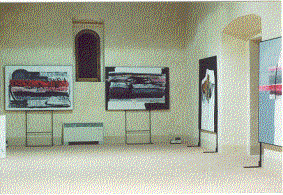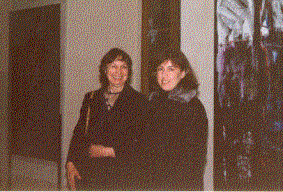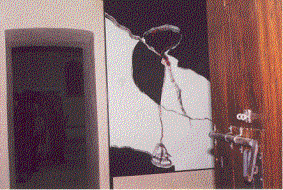

Rocca di Bazzano "Frammenti Spaziali"


Anna Boschi e Monica Miretti "Free air 1998" (part)

‘Frammenti’ spaziali
a cura di Monica Miretti
Bazzano Ascoli Piceno
Rocca dei Bentivoglio L’IDIOMA Centro d’Arte
25 marzo – 1 maggio 2000 15 – 27 aprile 2000
'Frammenti’ spaziali di Monica Miretti
Se ripenso agli incontri avvenuti con Anna Boschi nel suo studio, dove ho potuto ripercorrere il suo ormai lungo cammino, la prima impressione che ricordo con piacere e, soprattutto interesse, è legata a quel senso di energia traboccante che emanava dall’artista e si condensava nella ricchezza dei materiali che mi veniva ponendo innanzi, fino alle opere più recenti –appositamente selezionate per l’attuale esposizione– che sono certamente il risultato dello stratificarsi delle esperienze della Boschi nel corso di questi anni, in cui anche la sua poetica si è venuta sempre meglio definendo.
Il primo aspetto che emerge nell’attimo in cui ci si sofferma ad analizzare il lavoro dell’artista bolognese consiste nella sua evidente capacità di dominare lo spazio. Le ultime tele, di ampissime dimensioni, ne sono nitida testimonianza, ma ciò che va sottolineato è il non venir mai meno della sua forza espressiva, della sua intensità, sia che essa si esprima in forme dilatate, che investono intere pareti, sia che si concentri su interventi minuti o su singoli ‘frammenti’ compositivi, sia ancora che decida di invadere direttamente lo spazio.
Esiste, infatti, nel lavoro di Anna Boschi, un ricorrente rapporto pittura-oggetto, ma anche pittura-spazialità, che persiste nel tempo e la porta a pensare, e dunque creare, ‘strutture’ che entrino comunque in dialettica immediata con l’ambiente che le avvolge. Anche le tele, d’altronde, hanno ritmi che tendono a travalicare i limiti fisici del supporto: così, per esempio, le composizioni a più riquadri offrono idee di puzzles dilatabili che talvolta, come mostrano alcuni suoi interventi, giungono a tradursi in vere e proprie griglie ‘scultoree’, leggere, aeree, ma al contempo invasive.
A questa tensione verso l’esterno, che appare elemento intrinseco dell’operare della Boschi, si affianca costantemente una altrettanto insistita attenzione verso la materia: una materia che spazia dalla lievità misteriosa delle garze e delle veline alla seduzione dei plexiglass, o ancora alla corporeità più piena dei legni, dei ferri o degli impasti che si coagulano sulla tela, sulle forme da lei create o sulle pagine dei suoi ‘libri’. Lo stesso utilizzo reiterato di materiali diversificati (tra cui vanno annoverati anche polistirolo, faesite, carte di vario genere, cere etc.) che ora fungono da supporto, ora invece si attagliano alla superficie dell’opera come nel caso frequente dei collages -ma che sempre concorrono alla definizione del suo significato ultimo– apporta un surplus di sensazioni visive e tattili e, conseguentemente, emotive, che ne arricchisce la trama.
A ben considerare, infatti, il lavoro della Boschi nasce per ‘stratificazioni’ come espressione di un’esigenza manifesta, se pur controllata, di apporre segnali, ‘indicatori’ per chi osserva, non importa quale ne sia la natura: cromatica, tattile, verbale, segnica.
Ne scaturisce un racconto polifonico, in cui elemento predominante è la forma e la sua camaleontica capacità metamorfica. Non a caso, in questi ultimi anni di intensa attività, l’artista si è sempre più chiaramente orientata verso un ambito poetico-visuale che si è venuto inserendo sul primigenio impulso di stampo informale che caratterizzava le sue opere. In tal senso trovano ragion d’essere anche lo spiccato interesse per il libro d’artista e la mail art, di cui la Boschi si è resa, più ancora che promotrice instancabile, sensibile interprete.
Anna Boschi,
Rocca di Bazzano "Frammenti Spaziali"

Anna Boschi e Monica Miretti "Free air 1998" (part)